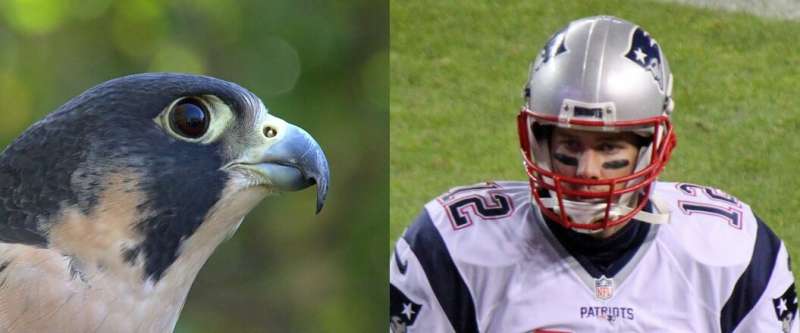New study suggests falcons have natural 'eye makeup' to improve hunting ability

Dark 'eyeliner' feathers of peregrine falcons act as sun shields to improve the birds' hunting ability, a new scientific study suggests.
Scientists have long speculated that falcons' eye markings improve their ability to target fast-moving prey, like pigeons and doves, in bright sunlight. Now research suggests these markings have evolved according to the climate; the sunnier the bird's habitat, the larger and darker are the tell-tale dark 'sun-shade' feathers.
The distinctive dark stripes directly beneath the peregrine falcon's eyes, called the malar stripe or 'moustache', likely reduce sunlight glare and confer a competitive advantage during high-speed chases. It's an evolutionary trait mimicked by some top athletes who smear dark makeup below their eyes to help them spot fast-moving balls in competitive sports.
Until now, there had been no scientific study linking solar radiation levels to the dark 'eyeliner' plumage, which is common to many other falcon species.
The study, published in the journal Biology Letters was conducted by researchers from the University of Cape Town (UCT) and the University of Witwatersrand, South Africa.
The scientists used photos of peregrine falcons from around the world posted on the web by bird watchers and scored the size of the malar stripe for each bird. They then explored how these malar stripes varied in relation to aspects of the local climate, such as temperature, rainfall, and strength of sunlight.
The study involved comparing malar stripe characteristics, including width and prominence, of individual peregrine falcons, by using over two thousand peregrine photographs stored in online citizen science libraries. Researchers examined samples from 94 different regions or countries. Results showed that peregrine falcon malar stripes were larger and darker in regions of the world where sunlight is stronger.
"The solar glare hypothesis has become ingrained in popular literature, but has never been tested empirically before," said Michelle Vrettos, an MSc student from UCT who carried out the research. Vrettos added: "Our results suggest that the function of the malar stripe in peregrines is best explained by this solar glare hypothesis."
Associate Professor Arjun Amar from the UCT FitzPatrick Institute, who supervised the research, said: "The peregrine falcon represents the ideal species to explore this long-standing hypothesis, because it has one of the most widespread distributions of all bird species, being present on every continent except Antarctica—it is therefore exposed to some of the brightest and some of the dullest areas around the globe".
Amar added: "We are grateful to all the photographers around the world that have deposited their photos onto websites. Without their efforts this research would not have been possible."
More information: Malar stripe size and prominence in peregrine falcons vary positively with solar radiation: support for the solar glare hypothesis, Biology Letters (2021). royalsocietypublishing.org/doi … .1098/rsbl.2021.0116
Journal information: Biology Letters
Provided by University of Cape Town



















